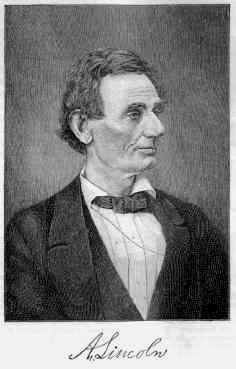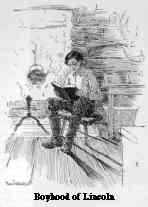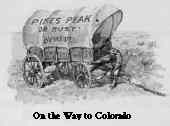Resource Center OLLibrary
|
274 |
|
[1860 |
States, then a nation of over 30,000,000. That party, though it
denounced John Brown's attempt (§ 314) as "lawless and
unjustifiable," pledged itself to shut out slavery from the
territories.
The people of South Carolina believed that the
election of Mr. Lincoln meant that the great majority of the North
was determined to bring about the liberation of the negroes. That
was a great mistake; but the Carolinians could not then be
convinced to the contrary. They furthermore saw that they could no
longer hope to maintain the power they once possessed in Congress,
for the free states now had six more senators and fifty-seven more
representatives than the slave states
had.1
On December 20, 1860, a convention met in
"Secession Hall," in Charleston, and unanimously voted "that the
union now subsisting between South Carolina and other states,
under the name of the United States of America, is hereby
dissolved." Those who thus voted said that it was no hasty
resolution on their part, but
destination, in what was then an almost unsettled country, the
father and son set to work to build the log cabin which was to be
their home; and when that was finished, young Lincoln split the
rails to fence in their farm of ten acres.
Such work was play to him. He was now
twenty-one; he stood six feet three and a half inches, barefooted;
he was in perfect health; could outrun, outjump, outwrestle, and,
if necessary, outfight any one of his age in that part of the
country, and "his grip was like the grip of Hercules." Without
this rugged strength he could never have endured the strain that
the nation later put upon him.
In 1834 he resolved to begin the study of law. A
friend in Springfield offered to lend him some books; Lincoln
walked there, twenty-two miles from New Salem (where he then
lived), and, it is said, brought back with him four heavy volumes
of Blackstone, at the end of the same day.
A few years later he opened a law office in
Springfield. In 1846 "Honest Abe," as his neighbors and friends
called him, was elected to Congress; and in 1860, to the
presidency of the United States, by the Republican party (Hannibal
Hamlin of Maine, Vice President). The Democratic party had split
into a Northern and a Southern party. The former had nominated
Stephen A. Douglas of Illinois, and the latter John C.
Breckenridge of Kentucky. The former American (or "Know Nothing")
party, which now called itself the "Constitutional Union Party,"
had nominated John Bell of Tennessee. Lincoln received nearly half
a million more votes than Douglas, and more than a million in
excess of those cast for either of the other candidates.
1 In 1790,
just after the foundation of the government, the free states (that
is, the northern states; they had comparatively few slaves) had 14
senators and 35 representatives in Congress; the slave states, 12
senators and 30 representatives. From 1796 to 1812, inclusive, the
free states and the slave states had an equal number in the
Senate, but the free states had a majority in the House. After
1848 the free states had a majority in both Senate and House, and
in the latter this majority was constantly increasing. That fact
meant that the South had lost its political power, partly because
slavery had failed to get a foothold in the Far West, but mainly
because the North had outgrown the South in population.

|
276 |
|
[1860-1861 |
|
that it had been under consideration for many years.
The declaration of secession was welcomed in the streets
of Charleston with the firing of cannon and the ringing
of bells. The citizens believed that they had broken up
the Union, and that South Carolina had now, as its
governor said, become a "free and independent state." |
|
1860-1861] |
|
277 |
The Confederate States now cast aside the Stars and Stripes,
and hoisted a new flag,--the Stars and Bars, in its place.
317. Why the South seceded; Seizure of
National Property; the Star of the West fired on. What
took these seven states -- soon to be followed by four more -- out
of the Union? The answer is, It was first their conviction that
slavery would thrive better by being separated from the influence
of the North and, secondly, it was their belief in "State Rights,"
or, better, State Sovereignty" (§ 269), upheld by South
Carolina as far back as Jackson's presidency. According to that
idea, any state was justified in separating itself from the United
States whenever it became convinced that it was for its interest
to withdraw.
In this act of secession many of the people of
the South took no direct part, -- a large number being, in fact,
utterly opposed to it, -- but the political leaders were fully
determined on separation. Their aim was to establish a great
slaveholding republic of which they should be
head.1
President Buchanan made no attempt to prevent
the states from seceding; part of his cabinet were Southern men,
who were in full sympathy with the Southern leaders, and the
President did not see how to act.
The seceded states seized the forts, arsenals,
and other national property within their limits, so far as they
could do so. Fort Sumter, commanded by Major Anderson of the
United States army, in Charleston harbor, was one of the few where
the Stars and Stripes remained flying. President Buchanan had made
an effort to send men and supplies to Major Anderson by the
merchant steamer Star of the West (January 9, 1861); but
the people of Charleston fired upon the steamer, and compelled her
to go back.
1 Alexander H.
Stephens, Vice President of the Confederacy, said, in a speech at
Savannah, March 21, 1861: "The prevailing idea entertained by him
[Jefferson] and most of the leading statesmen at the time
of the formation of the old Constitution [the Constitution of
the United States] was that the enslavement of the African was
in violation of the laws of nature; that it was wrong in principle
-- socially, morally, and politically.... Our new government
[the Southern Confederacy] is founded upon exactly the
opposite idea; its foundations are laid, its corner stone rests,
upon the great truth that the negro is not equal to the white man;
that slavery -- subordination to the superior race -- is his
natural and normal condition."
--MCPHERSON'S
Political History of the Rebellion, p. 103
|
278 |
|
[1862 |
|
All eyes were now turned toward
Abraham Lincoln. The great question was, What will he do
when he becomes President? |
|
1861] |
|
279 |
coming more and more to the front. Emigrants, miners, and other
pioneers of civilization were constantly pushing forward into the
vast region beyond the Mississippi. There they were building the
first rude shanties of settlements which were to become known as
Omaha (1854) and Denver (1858), and they were laying the
foundations of the twelve great states1 which, with
West Virginia, have since joined the Union.
But between 1789 and 1861 there was this sad
difference: Washington had found and left us a united people;
Buchanan, a divided people. Seven of our states had seceded; four
more would go. For many years we had been brothers; now we were
fast becoming enemies. Only let the word be spoken, and our swords
would leap from their scabbards, and we would fly at each other's
throats.
What had brought about this deplorable change?
Time. Time had strengthened slavery at the South and freedom at
the North. It was no longer possible for both to dwell together in
peace under the same flag. Either the Union must be dissolved, or
those who loved the Union must fight to save it; and, before the
war should end, must fight to make it wholly free. If freedom
should triumph, then lasting peace would be restored; for then the
North and the South -- no longer separated by slavery -- would
again become one great, prosperous, and united people.
1 The twelve states
are Kansas, Nevada, Nebraska, Colorado, North Dakota, South
Dakota, Montana, Washington, Idaho, Wyoming, Utah, and Oklahoma.
They entered the Union between January, 1861, and November,
1907.
 Alabama,
Louisiana, and Texas -- making seven in all -- had
likewise withdrawn from the Union. A seceding senator
rashly declared that they had left the national
government "a corpse lying in state in Washington."
Delegates from these states met at Montgomery, Alabama.
They framed a government (1861) and took the name of the
"Confederate States of America," with Montgomery as the
capital; then they elected Jefferson Davis1 of
Mississippi, President of the Confederacy, and Alexander
H. Stephens2 of Georgia, Vice President.
Alabama,
Louisiana, and Texas -- making seven in all -- had
likewise withdrawn from the Union. A seceding senator
rashly declared that they had left the national
government "a corpse lying in state in Washington."
Delegates from these states met at Montgomery, Alabama.
They framed a government (1861) and took the name of the
"Confederate States of America," with Montgomery as the
capital; then they elected Jefferson Davis1 of
Mississippi, President of the Confederacy, and Alexander
H. Stephens2 of Georgia, Vice President. see
that over seventy years had elapsed since the formation
of the Union. We then had a population of less than
4,000,000; at the outbreak of secession (1860) we had
eight times that number, and much more than eight times
the wealth possessed by us in 1789. Thus, from a small
and poor nation we had grown to be great and
prosperous.
see
that over seventy years had elapsed since the formation
of the Union. We then had a population of less than
4,000,000; at the outbreak of secession (1860) we had
eight times that number, and much more than eight times
the wealth possessed by us in 1789. Thus, from a small
and poor nation we had grown to be great and
prosperous.


